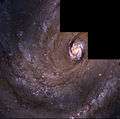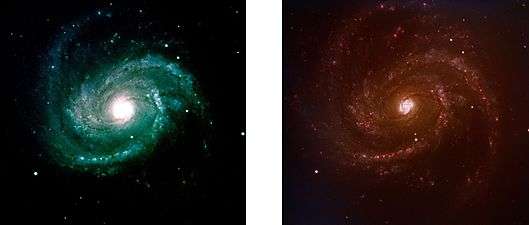Messier 100
| Messier 100 | |
|---|---|
 | |
| Observation data (J2000 epoch) | |
| Constellation | Coma Berenices[1] |
| Right ascension | 12h 22m 54.9s[2] |
| Declination | +15° 49′ 21″[2] |
| Redshift | 1571 ± 1 km/s[2] |
| Distance | 55 Mly[3] |
| Apparent magnitude (V) | 9.5[2] |
| Characteristics | |
| Type | SAB(s)bc[2] |
| Size | 107,000 ly (diameter) |
| Apparent size (V) | 7′.4 × 6′.3[2] |
| Other designations | |
| NGC 4321 | |
Messier 100 (also known as NGC 4321) is an example of a grand design[4] intermediate spiral galaxy located within the southern part of constellation Coma Berenices. It is one of the brightest and largest galaxies in the Virgo Cluster, located approximately 55 million light-years[3] distant from Earth and has a diameter of 107,000 light years. It was discovered by Pierre Méchain on March 15, 1781 and was subsequently entered in Messier’s catalogue of nebulae and star clusters[5] after Charles Messier[6] made observations of his own on April 13, 1781. The galaxy was one of the first spiral galaxies[6] to be discovered, and was listed as one of fourteen spiral nebulae by Lord William Parsons of Rosse in 1850. Two satellite galaxies[7][8] named NGC 4323 -connected with M100 by a bridge of luminous matter- and NGC 4328 are present within this galaxy.
Early observations
After the discovery of M100 by Méchain, Charles Messier made observations of the galaxy depicting it as a nebula without a star. He pointed out that it was difficult[6] to recognize the nebula because of its faintness. William Herschel was able to identify a bright cluster of stars[6] within the nebula during observations he did before John Herschel expanded the findings in 1833. With the advent of better telescopes, John Herschel was able to see a round, brighter galaxy; however, he also mentioned that it was barely visible through clouds. William Henry Smyth[6] extended the studies of M100, detailing it as a pearly white nebula and pointing out diffuse spots.
Star formation
Messier 100 is considered a starburst galaxy[9] with the strongest star formation activity concentrated in its center, within a ring - actually two tightly wound spiral arms attached to a small nuclear bar[10] with a radius of 1 kilo-parsec - where star formation has been taking place since at least 500 million years ago in separate bursts.[11]
As usual on spiral galaxies of the Virgo Cluster, in the rest of the disk both star formation[12] and neutral hydrogen, of which M100 is deficient compared to isolated spiral galaxies of similar Hubble type,[13] are truncated within the galaxy's disk, which is caused by interactions with the intracluster medium of Virgo.
Supernovae
Five supernovae[4] have been identified in the M100 galaxy. In March 1901 the first supernova of M100 was found, SN 1901B,[4][14] a type I supernova found when magnitude 15.6 at a distance from its nucleus. SN 1914A[4][15] was then discovered in February to March 1914; its type was undeterminable but was found when magnitude 15.7 at some distance from the center. Observations of M100 from February 21, 1960 to June 17, 1960 led to the discovery of SN 1959E, another type I supernova,[4][16] with the faintest magnitude, 17.5, among the five found, at 58"E and 21"S from its nucleus. On April 15, 1979, the first type II supernova found in the M100 galaxy was discovered; however the star SN 1979C[4][17] faded quickly; later observations from x-ray to radio wavelengths revealed its remnant. The latest supernova was discovered February 7, 2006; the star SN 2006X[4][18] had a magnitude of 15.3 when discovered two weeks before fading to magnitude +17.
Images
 Image from the FORS instrument on the Very Large Telescope
Image from the FORS instrument on the Very Large Telescope Core of Messier 100 taken with the high-resolution channel of Hubble Space Telescope's Advanced Camera for Surveys.
Core of Messier 100 taken with the high-resolution channel of Hubble Space Telescope's Advanced Camera for Surveys.
 Central region imaged by the Hubble Space Telescope
Central region imaged by the Hubble Space Telescope


 24-inch telescope on Mt. Lemmon, AZ.
24-inch telescope on Mt. Lemmon, AZ. Hubble Space Telescope image processed by Judy Schmidt
Hubble Space Telescope image processed by Judy Schmidt
References
- ↑ R. W. Sinnott, ed. (1988). The Complete New General Catalogue and Index Catalogue of Nebulae and Star Clusters by J. L. E. Dreyer. Sky Publishing Corporation/Cambridge University Press. ISBN 0-933346-51-4.
- 1 2 3 4 5 6 "NASA/IPAC Extragalactic Database". Results for NGC 4321. Retrieved 2006-08-31.
- 1 2 "Messier 100". Hearst Observatory. Retrieved 2010-02-23.
- 1 2 3 4 5 6 7 "Messier 100". SEDS: Spiral Galaxy M100 (NGC 4321), type Sc, in Coma Berenices. Retrieved 2010-02-23.
- ↑ "Catalog of Nebulae and Star Clusters". SEDS. Retrieved 2010-02-23.
- 1 2 3 4 5 "Messier 100". SEDS: Observations and Descriptions. Retrieved 2010-02-23.
- ↑ S. di Serego Alighieri; et al. (2007). "The HI content of Early-Type Galaxies from the ALFALFA survey I. Catalogued HI sources in the Virgo cluster". Astronomy and Astrophysics. 474 (3): 851–855. arXiv:0709.2096
 . Bibcode:2007A&A...474..851D. doi:10.1051/0004-6361:20078205.
. Bibcode:2007A&A...474..851D. doi:10.1051/0004-6361:20078205. - ↑ "NGC 4323". SIMBAD. Retrieved 2010-02-23.
- ↑ Wozniak, H.; Friedli, D.; Martinet, L.; Pfenniger, D. (1999). "Double-barred starburst galaxies viewed by ISOCAM". The Universe as Seen by ISO.: 989. Bibcode:1999ESASP.427..989W.
- ↑ Sakamoto, Kazushi; Okumura, Sachiko; Minezaki, Takeo; Kobayashi, Yukiyasu; et al. (1995). "Bar-Driven Gas Structure and Star Formation in the Center of M100". The Astronomical Journal. 110 (3): 2075. Bibcode:1995AJ....110.2075S. doi:10.1086/117670.
- ↑ Allard, E. L.; Knapen, J. H.; Peletier, R. F.; Sarzi, M. (2006). "The star formation history and evolution of the circumnuclear region of M100". Monthly Notices of the Royal Astronomical Society. 371 (3): 1087–1105. arXiv:astro-ph/0606490
 . Bibcode:2006MNRAS.371.1087A. doi:10.1111/j.1365-2966.2006.10751.x.
. Bibcode:2006MNRAS.371.1087A. doi:10.1111/j.1365-2966.2006.10751.x. - ↑ R. A. Koopmann; J. D. P. Kenney (2004). "Hα Morphologies and Environmental Effects in Virgo Cluster Spiral Galaxies". Astrophysical Journal. 613 (2): 866–885. arXiv:astro-ph/0406243
 . Bibcode:2004ApJ...613..866K. doi:10.1086/423191.
. Bibcode:2004ApJ...613..866K. doi:10.1086/423191. - ↑ Chung, A.; Van Gorkom, J.H.; Kenney, J.F.P.; Crowl, Hugh; et al. (2009). "VLA Imaging of Virgo Spirals in Atomic Gas (VIVA). I. The Atlas and the H I Properties". The Astronomical Journal. 138 (6): 1741–1816. Bibcode:2009AJ....138.1741C. doi:10.1088/0004-6256/138/6/1741.
- ↑ "SN 1901B -- SuperNova". SIMBAD. Retrieved 2010-02-23.
- ↑ "SN 1914A -- SuperNova". SIMBAD. Retrieved 2010-02-23.
- ↑ "SN 1959E -- SuperNova". SIMBAD. Retrieved 2010-02-23.
- ↑ "SN 1979C -- SuperNova". SIMBAD. Retrieved 2010-02-23.
- ↑ "SN 2006X -- SuperNova". SIMBAD. Retrieved 2010-02-23.
External links
| Wikimedia Commons has media related to Messier 100. |
- SEDS: Spiral Galaxy 100
- Messier 100 on WikiSky: DSS2, SDSS, GALEX, IRAS, Hydrogen α, X-Ray, Astrophoto, Sky Map, Articles and images
- ESA/Hubble Messier 100
Coordinates: ![]() 12h 22m 54.9s, +15° 49′ 21″
12h 22m 54.9s, +15° 49′ 21″
